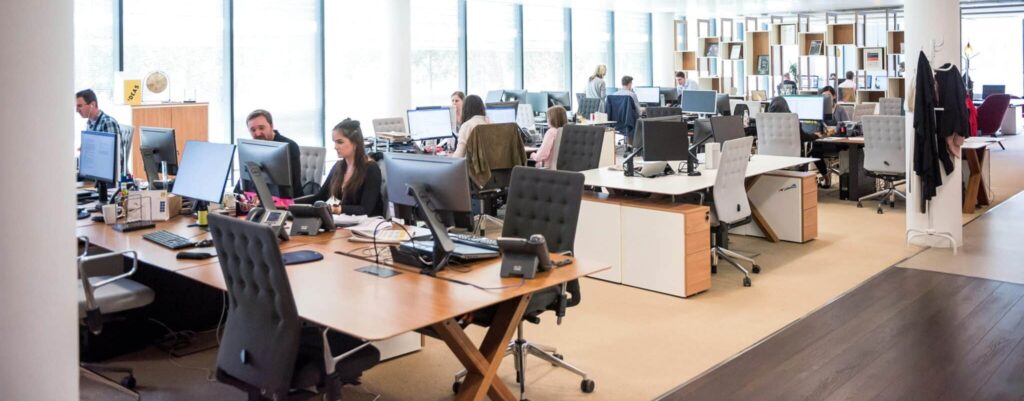The Privacy Problem: How IT and HR Can Help in a Crowded Office

As with most seismic shifts in the office design world, trends like open-plan seating and hot desking come with equal measures of praise and controversy. Many of the concerns surrounding these new layouts boil down to the idea of privacy. Whether an office removes its cubicles or opts out of permanent seating, employees are almost certain to experience a new level of awareness of their neighbors and ambient noise. This increase in stimuli has the potential to impact productivity, and open floor plans can also introduce security risks if employees don’t have dedicated spaces from which to work on sensitive information.
While facility managers are often on the hook for resolving privacy challenges in open and crowded offices, HR and IT can also help curtail the potential shortcomings of crowded open offices. Navigating the challenges of fewer walls can be more effective with a cross-departmental effort—here’s how.
1. Embrace the cloud—and embrace it some more
Many workplaces—particularly those weighing the benefits of tech-backed changes like hot desking—have embraced cloud technology to a large degree, but it’s worth a second look to see how this technology can help employees maintain privacy at the individual level. IT should be able to jump in here to suggest systems, processes, applications and hardware that make it easier for employees to move to different workstations in the office securely.
Keeping your company’s crucial data in the cloud as opposed to stored on employees’ hard drives (or on paper) ensures that sensitive information doesn’t accidentally end up in the wrong hands, or become lost in a computer upgrade. It also means that if one area of the office is particularly loud on a given day, employees can take advantage of alternate workspaces in the office in order to focus—employees given consistent access to key files and services on the cloud via login can carry sensitive documents from desk to desk without worrying about accidentally leaving something behind.
Technology today gives offices with privacy concerns some much-needed flexibility.
Consider things like security tokens, identity and access management (IAM) solutions and virtual private networks (VPNs) to give your employees the freedom to work anywhere, even when the nature of their work is sensitive. By making use of the latest security measures that technology has to offer, you can give employees the freedom and privacy they’re asking for without putting company data at risk.
2. Open up remote working

When your seating becomes flexible in-house, consider extending your employees the option to take that flexibility all the way outside. The right combination of HR policy and IT expertise allows employees to work from pretty much anywhere—around the world, 70% of people work remotely at least once a week.
Along with embracing cloud technology and digital security solutions, a clear work-from-home policy and designated communication software—like Slack, Skype and Google Docs—are the other important privacy initiatives HR and IT can spearhead. Providing adequate privacy can be as simple as allowing employees to work a few hours outside the office every week. If the rules are clear and your employees have everything they need to communicate effectively with the office, there’s no reason why productivity needs to suffer simply because there aren’t as many people working in-house.
If your organization is worried about losing touch with employees who are spending less time in the office, there are simple strategies you can use to make sure that teams keep operating as cohesive units. Mandatory in-office days, company social events and regular face-to-face check-ins are easy ways to keep employees connected.
3. Implement “flaggable” solitude

Finally, privacy doesn’t need to be about intentional or unintentional access to private files and conversations—sometimes, it’s just about the desire to be left alone. IT and HR have numerous strategies to help provide employees with uninterrupted work time. Employing these strategies relies on two things: employees who desire privacy must signal their need to others, and those who feel the need to intrude must respect the sign.
That said, the sign doesn’t need to be a literal “Unavailable” sign. Headphones or small green or red flags on desks can be all it takes to ward off intrusion—HR can take point on setting the tone for solitude signals and getting the word out company-wide. For IT, meanwhile, making status changes available within the office’s collaboration tools can carry similar effects. It’s a low-impact, low-effort approach to addressing privacy concerns.
However your office decides to resolve issues of privacy in open-plan spaces, remember that leveraging communication is key. Poll employees and test solutions to see what works best for your office.
Relieve some of the headaches of planning for privacy by leveraging a scalable IWMS platform. Request a demo of OfficeSpace, and see how our solutions can benefit everyone from FMs to HR and IT.
Photo Credits: Shutterstock / wavebreakmedia, Shutterstock / WAYHOME studio, Shutterstock / Jacob Lund




